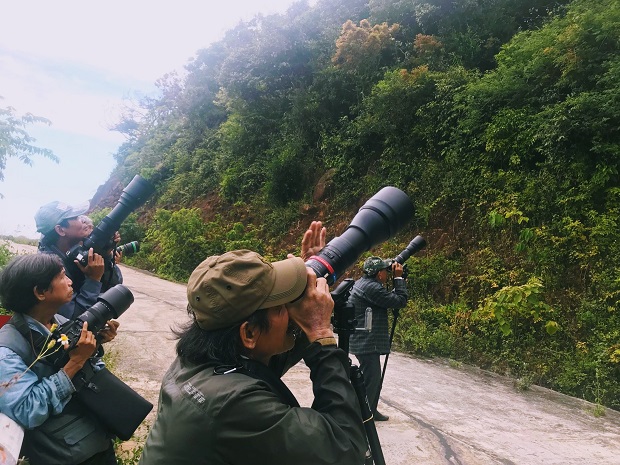Beauty of red-shanked douc langurs attractive to domestic and foreign photographers
Recent years have seen a growing number of both professional and amateur photographers visiting Da Nang’s Son Tra Peninsula, around 10km from the city’s heart, to capture the amazing beauty of red-shanked douc langurs living there.
 |
The Son Tra Peninsula is now home to around 530 red-shanked douc langurs, which accounts for 83% of the world’s total primate species.
Thanks to its unique beauty with 5 impressive colours, the red-shanked douc langur has been recognised by the Wildlife at Risk international organisation as the ‘Queen’ of the primate species.
It belongs to Group IIB which is rare animals restricted from being held in captivity, hunted, traded or killed.
Nguyen Ba Thuc, 50, a Da Nang native, started taking stunning photos of red-shanked douc langurs 3 years ago, and his sentimental attachment to this rare species of animal has strengthened day after day.
Thuc is very impressed by the colourfulness of this rare primate species which sports maroon-red ‘stockings’ from its knees to its ankles, and appears to wear white forearm length ‘gloves’.
Its look is accentuated by black hands and feet.
The animal’s face is so cute that those who see it at first can not keep their eyes off it.
Like Thuc, other photographers usually go to the peninsula to take photos of red-shanked douc langurs, normally twice a day, 4.00am – 9.00am, and 3.00pm and 6.00pm. These are the periods of time when the langurs, regularly appear and forage around the peninsula.
These photographers usually wear dark clothes or camouflage themselves with leaves, make no noise, use cameras with telephoto lens to keep a certain distance from langurs, manage to find closer viewings of langurs, carefully observe their social and motor behaviour, and then capture the best possible moments.
Actually, following such steps is not an easy task!
A young female photographer from Son Tra District said one of the toughest challenges during the shootings is how to capture moments vividly reflecting the personality traits of langurs, like mischievousness, curiosity, and cleverness.
 |
| Photographers being keen on capturing the amazing beauty of red-shanked douc langurs |
The charm of langurs also draws a great deal of attention from foreign visitors, and amongst them is Tetsuo Kogai from Japan.
During his 10-day stay in this beautiful seaside city, this Japanese holiday-maker spent much of his time taking photos of the ‘Queen’ of the primate species.
Through such a meaningful trip to the peninsula, foreigners like Kogai would have deeper insight into the unique beauty of langurs, as well as their living habits and natural habitant on the peninsula which is considered to be a precious natural gift and a ‘green lung’ for the city.
It is the fact that, apart from their eye-catching colourful beauty, red-shanked douc langurs’ human-like behaviour is indeed one of the most impressive.
It is observed most often when a mother monkey tries to get her infants to stop doing an action she disapproved of. In what is both adorable and heartbreaking, a mother monkey shows her love affection to her young baby monkey in the green forest setting.
Such lovely moments of this species of animal really arouse deep feelings amongst photographers, and inspired them to pursue their exciting discovery journey through their lens.